Tracked MTB or amphibious tank ?
The Grillo is one of the least known Italian small craft of ww1, and for good reasons as on an operational level it did not really moved the needle. But this was one of these purpose-built mechanical contraptions that escape all classifications. General assumption is the Grillo are tracked MTBs because of the programme, construction techniques, and deployment by the Italian Navy. But in general conception it can be compared to the Japanese Type 4 Ka-Tsu. In short, it was not a tank designed to be amphibious, but rather at its core, a Motor Torpedo Boat modified with a chain of grippling hooks, track-like device, and that’s the reason it its covered here on naval-encyclopedia.com.
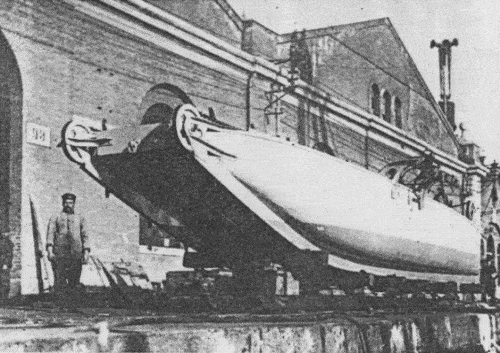
The Grillo in SVAN yard, venice, 1918.
Development of the Grillo
The Grillo (“Cricket”), was a MAS boat (Motorbarca Armata SVAN or ), from the SVAN yards, designed by engineer Attilio Bisio. The subject is quite interesting in itself as more than four hundreds of these were built until the end of the war, literally forbidding the Austro-Hungarian navy to leave Pola Harbour, even more after battleship Szent Istvan was sunk by one of these. The paradox is the Navy is often rather the more conservative of all arms, but in that case, was the first to introduce “tanks” in combat.
The Grillo were designated “climbing boats” or even “jumping boats” according to the initial barchino saltatore designation. They had been designed specifically by Engineer Attilio Bisio at SVAN yards to overcome harbour barrages (with Pola in mind) designed to prevent the small MAS to rush in. The goal was to produce a small serie of these crafts, that will launch their torpedoes when in, possibly by night, and then climb out the same way to safety.
In the larger picture, the Grillo registered in the change of doctrine of the Italian Navy induced by the introduction of numerous light vessels of the MAS type and the Grillo registered together with the mignatta (“leech”), and the latter Torpedine Semovente Rossetti or Rossetti self-propelled torpedo. Perhaps excessive caution from both fleets also led to this economical “small warfare” where limited means could bring maximal destruction. It was confirmed when MAS sunk the battleships Wien (December 1917) and Szent Istvan (June 1918), and even more when in November, just before reddition, battleship Viribus Unitis was sunk by a single frogman.
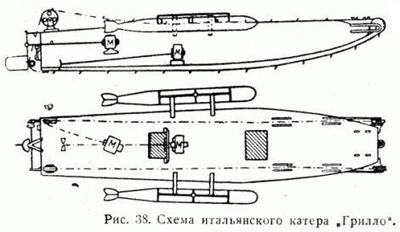
Blueprint, two-views of the model
Design of the Grillo
It was designed as a fast boat, all in wood, with rounded sides, and a rectangular, narrow flat bottom surrounded on both sides by rails. These comprised a serie of narrow links, with grippling hooks welded on every two of these. Drive sprockets were at the front, and large idlers were fitted up at the boat’s back, while the links circulated thanks to two more bottom wheels at the front per side, and two tender wheels at the back. The tracks rested on the bridge but were raised by the open air wheel pair at the rear which acted as manageable tension wheels.
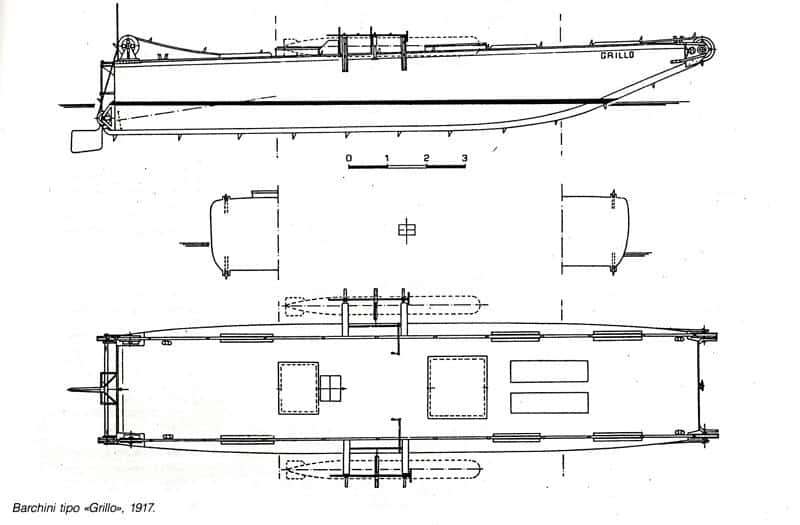
The four units were 16m long, 3.10m in width, with a 70cm draft. In fact the rear tensioners and front sprockets acted like toothed pulleys. The aft ones, near the obstacle to overcome, were coupled to the propulsion system. The power required quietness, and consisted of a pair of 5 hp electric motors. The hooked chains were designed to pull the vehicle over the obstruction. They were officially known as “tank marino”. The weaponry consisted in two aircraft type light 450 mm torpedoes (same as MAS) held in cradles each side of the hull. The 2 electric motors Rognini and Balbo on 1 axle, for 10 hp overall, made for a top speed of 4 knots (7,4 kph) and a radius of action of 30 mn at 4 knots, which required the boats to be towed or carried near to the action. These boats were manned by a crew of only four and were all named after jumping insects (Grasshopper, Cricket, Locust …)
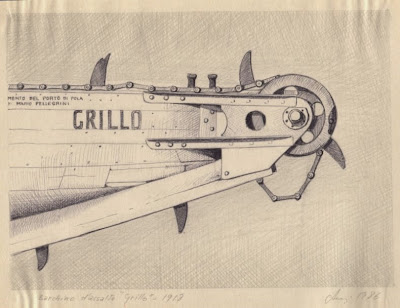
Prow of the Grillo
The Attack on Pola
Already Fazana channel’s forcing action in the night between 1 and 2 November 1916, showed by having a weight to lower the metal obstruction at the mouth of the canal and let passing MAS through inspired Attilio Bisio, director Of SVAN in Venice for a boat capable of doing it by its own weight. He proposed his idea to vice-admiral, Paolo Thaon di Revel in june 1917 just when an attack on Pola was in preparation. Its entrance protection system, was multilayered and consisted of several parallel lines of metallic obstructions. Hand-held hydraulic shears could no longer overcome them. Therefore a light naval vehicle which could literally leap these protection nets forward with the same capabilities as MAS boats was all that was required. This crossing could be obtained by means of sudden changes in trim from the displacement from electric accumulators acting on the motors housed on sliding carriages underneath.
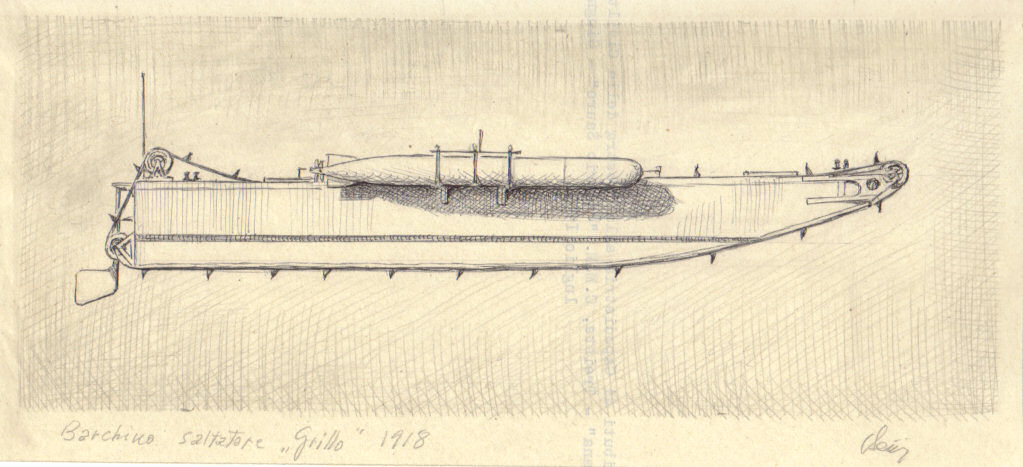
Drawing of the type
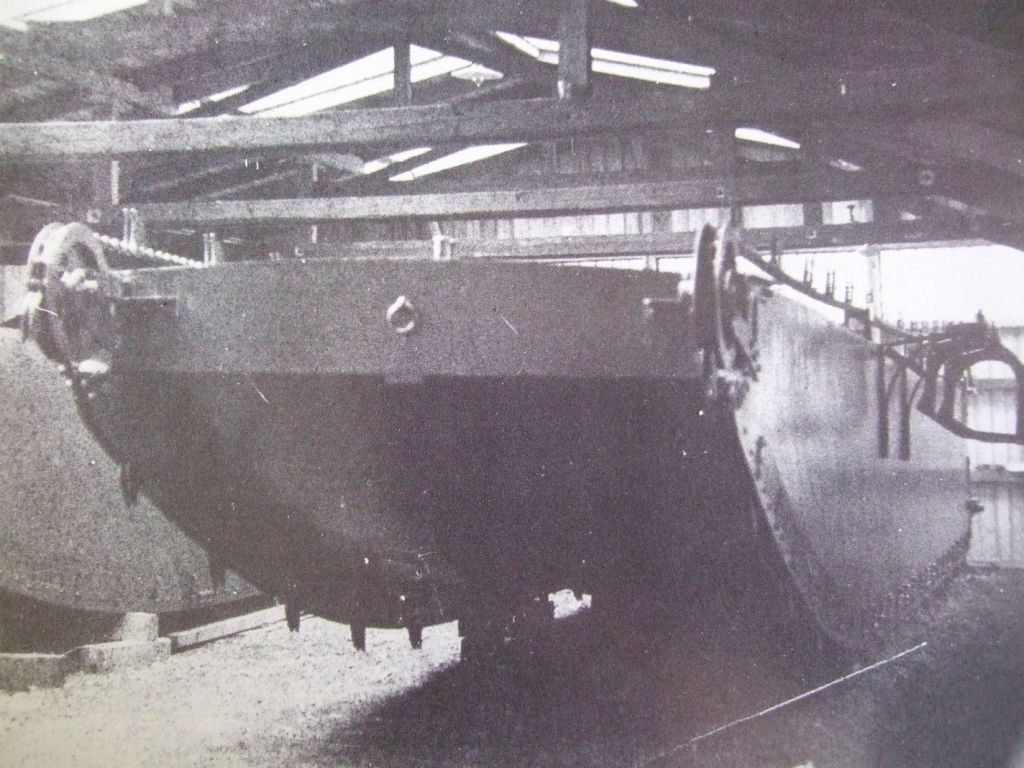
The Austrian copy of the Grillo, never tested.
At the end the Grillo left mitigated impressions, but impressed the Austrian navy enough to raise the Grillo and copy it at the end of the war. The idea of “naval tanks” was also shared by Great Britain that designed an amphibious tank, the Mark IX duck also in 1918.
Grillo specifications |
|
| Dimensions | Length 16m, Beam 3.1m , Draft 0,7m |
| Displacement | 8 Tonnes |
| Crew | 4 |
| Propulsion | 2 screws, 2 electric engines, 20 hp combined |
| Speed | 4 knots (7 km/h) |
| Range | 30 nmi at 4 kn (7 km/h; 12 mph) |
| Armament | 2 x 450 mm torpedoes |
| Armor | None |
Links/Sources
http://forlornhopesui.blogspot.fr/2015/05/grillo-plus-wwi.html
https://it.wikipedia.org/wiki/Barchino_saltatore
http://landships.activeboard.com/t48818775/grillo/
http://www.icsm.it/articoli/ri/marinaaustriacavsmas.html
http://xflottigliamas.forumfree.it/?t=28772765
http://www.betasom.it/forum/index.php?showtopic=40736&hl=grillo
http://worldatwar.net/chandelle/v1/v1n2/adriatic.html
https://laststandonzombieisland.com/tag/grillo/


 Latest Facebook Entry -
Latest Facebook Entry -  X(Tweeter) Naval Encyclopedia's deck archive
X(Tweeter) Naval Encyclopedia's deck archive Instagram (@navalencyc)
Instagram (@navalencyc)





 French Navy
French Navy Royal Navy
Royal Navy Russian Navy
Russian Navy Armada Espanola
Armada Espanola Austrian Navy
Austrian Navy K.u.K. Kriegsmarine
K.u.K. Kriegsmarine Dansk Marine
Dansk Marine Nautiko Hellenon
Nautiko Hellenon Koninklije Marine 1870
Koninklije Marine 1870 Marinha do Brasil
Marinha do Brasil Osmanlı Donanması
Osmanlı Donanması Marina Do Peru
Marina Do Peru Marinha do Portugal
Marinha do Portugal Regia Marina 1870
Regia Marina 1870 Nihhon Kaigun 1870
Nihhon Kaigun 1870 Preußische Marine 1870
Preußische Marine 1870 Russkiy Flot 1870
Russkiy Flot 1870 Svenska marinen
Svenska marinen Søværnet
Søværnet Union Navy
Union Navy Confederate Navy
Confederate Navy Armada de Argentina
Armada de Argentina Imperial Chinese Navy
Imperial Chinese Navy Marinha do Portugal
Marinha do Portugal Mexico
Mexico Kaiserliche Marine
Kaiserliche Marine 1898 US Navy
1898 US Navy Sovietskiy Flot
Sovietskiy Flot Royal Canadian Navy
Royal Canadian Navy Royal Australian Navy
Royal Australian Navy RNZN Fleet
RNZN Fleet Chinese Navy 1937
Chinese Navy 1937 Kriegsmarine
Kriegsmarine Chilean Navy
Chilean Navy Danish Navy
Danish Navy Finnish Navy
Finnish Navy Hellenic Navy
Hellenic Navy Polish Navy
Polish Navy Romanian Navy
Romanian Navy Turkish Navy
Turkish Navy Royal Yugoslav Navy
Royal Yugoslav Navy Royal Thai Navy
Royal Thai Navy Minor Navies
Minor Navies Albania
Albania Austria
Austria Belgium
Belgium Columbia
Columbia Costa Rica
Costa Rica Cuba
Cuba Czechoslovakia
Czechoslovakia Dominican Republic
Dominican Republic Haiti
Haiti Hungary
Hungary Honduras
Honduras Estonia
Estonia Iceland
Iceland Eire
Eire Equador
Equador Iran
Iran Iraq
Iraq Latvia
Latvia Liberia
Liberia Lithuania
Lithuania Mandchukuo
Mandchukuo Morocco
Morocco Nicaragua
Nicaragua Persia
Persia San Salvador
San Salvador Sarawak
Sarawak Uruguay
Uruguay Venezuela
Venezuela Zanzibar
Zanzibar Warsaw Pact Navies
Warsaw Pact Navies Bulgaria
Bulgaria Hungary
Hungary

 Bundesmarine
Bundesmarine Dutch Navy
Dutch Navy Hellenic Navy
Hellenic Navy Marina Militare
Marina Militare Yugoslav Navy
Yugoslav Navy Chinese Navy
Chinese Navy Indian Navy
Indian Navy Indonesian Navy
Indonesian Navy JMSDF
JMSDF North Korean Navy
North Korean Navy Pakistani Navy
Pakistani Navy Philippines Navy
Philippines Navy ROKN
ROKN Rep. of Singapore Navy
Rep. of Singapore Navy Taiwanese Navy
Taiwanese Navy IDF Navy
IDF Navy Saudi Navy
Saudi Navy Royal New Zealand Navy
Royal New Zealand Navy Egyptian Navy
Egyptian Navy South African Navy
South African Navy






























 Ukrainian Navy
Ukrainian Navy dbodesign
dbodesign